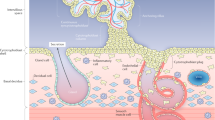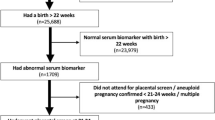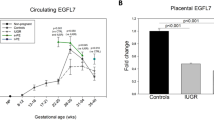Abstract
Low birth weight is a significant cause of morbidity and mortality among newborns, and may result from impaired placental function during the first trimester of pregnancy1. Here we show that the risk of delivering a low-birth-weight baby at term after an uncomplicated pregnancy varies with maternal circulating concentrations of a placental protein, pregnancy-associated plasma protein-A (PAPP-A) in the first 10 weeks after conception. Poor fetal growth may therefore already have been determined by the time obstetric monitoring begins after completion of the first trimester.
Similar content being viewed by others
Main
PAPP-A acts as a protease on the binding proteins of insulin-like growth factor (IGF)2,3 and may therefore increase the known stimulatory effects of placental IGFs4. Circulating concentrations of PAPP-A increase during the first three months of pregnancy, and this protein is highly expressed in trophoblasts5. We therefore investigated a possible link between the birth weight of a baby at term and maternal levels of PAPP-A during the first trimester. We determined the specificity of associations with PAPP-A by comparing it with the free β-subunit of human chorionic gonadotrophin (β-CG), another trophoblast-derived protein whose circulating levels change in the first trimester6 but which is functionally unrelated to the IGF system.
As part of a prospective, multicentre, non-interventional cohort study, we obtained serum from 4,288 women at 8–12 weeks of gestation (dated by ultrasound, equivalent to 6–10 weeks after conception), who ultimately had uncomplicated singleton pregnancies and delivered normal, live babies at full term. We had complete data for these women on maternal age, parity, height, body-mass index, race and smoking status.
Serum levels of PAPP-A and free β-CG were measured using a Kryptor immunoassay analyser (Brahms Diagnostica) and converted to multiples of the appropriate gestational median (MOM), corrected for smoking status7 and maternal weight8.
There was a greater proportion of low-birth-weight infants (under 2,500 g) delivered to women with a first-trimester PAPP-A concentration in the lowest 5% (9 out of 201, 4.5%) compared with other women (65 out of 4,087, 1.6%; P = 0.002). Using multivariate logistic regression (adjusting for maternal height, race, body-mass index, smoking status and elective delivery), a one log10 unit increase in first trimester PAPP-A MOM (roughly equivalent to the range from the 1st to the 99th percentile) was associated with an 80% reduction in the risk of a low-birth-weight baby (adjusted odds ratio, 0.2; 95% CI, 0.1–0.6; P = 0.002). In contrast, there was no significant independent relationship in the case of free β-CG (adjusted odds ratio, 0.6; 95% CI, 0.2–1.3; P = 0.17).
The factors that determine variation in birth weight are fetal growth and the duration of pregnancy. We examined the relationship between PAPP-A concentration and fetal growth using multiple linear-regression analysis, and identified a strong, positive correlation between first-trimester levels of PAPP-A and eventual birth weight at 38–41 weeks of gestation (Fig. 1a). There was no strong association between free β-CG levels and birth weight at the same gestational age.
a, Eventual birth weight plotted against PAPP-A multiples of the median (MOM; on a log10 scale) from a linear regression analysis. Curves (from bottom to top) represent gestational ages of 38, 39, 40 and 41 weeks. Coefficients (95% CI) for change in birth weight associated with a one log10 unit change in PAPP-A MOM: 38 weeks, 380 (209–552); 39 weeks, 231 (113–349); 40 weeks, 196 (104–289); 41 weeks, 221 (112–331); P < 0.0001 in each case. Coefficients were virtually unchanged after adjusting for age, parity, body-mass index, height, smoking status and race. b, Cumulative hazard (Nelson–Aelen cumulative hazard function10) of spontaneous labour on each day of gestation at full term, comparing the lowest (top curve) and highest (bottom curve) quintiles of first-trimester PAPP-A MOMs. Univariate comparison, P = 0.0003 (log rank test).
The relationship between first-trimester concentrations of PAPP-A or free β-CG and the timing of labour at full term was determined using time-to-event analysis9. Vaginal delivery after non-induced labour was taken as the event and all other modes of delivery were treated as censored. Lower concentrations of PAPP-A during the first trimester were associated with an earlier onset of spontaneous labour at full term (Fig. 1b).
In a multivariate proportional hazards model, there was a strongly additive and inverse relationship between levels of PAPP-A and free β-CG, and the likelihood of spontaneous labour on any given day of gestation at full term (adjusted hazard ratio for a one log10 unit change in MOM (95% CI): PAPP-A, 0.81 (0.69–0.96), P = 0.003; free β-CG, 0.79 (0.69–0.91), P < 0.001).
The association between PAPP-A levels, fetal growth and the timing of labour is biologically plausible, as PAPP-A is highly expressed in first-trimester trophoblasts5 and may be responsible for activation of IGFs. Our results indicate that the risk of delivering a low-birth-weight baby at full term may be determined by the placental activity of IGFs in very early pregnancy.
References
Smith, G. C. S., Smith, M. F. S., McNay, M. B. & Fleming, J. E. E. N. Engl. J. Med. 339, 1817–1822 (1998).
Lawrence, J. B. et al. Proc. Natl Acad. Sci. USA 96, 3149–3153 (1999).
Laursen, L. S. et al. FEBS Lett. 504, 36–40 (2001).
Rutanen, E. M. Curr. Opin. Obstet. Gynecol. 12, 163–168 (2000).
Overgaard, M. T. et al. Biol. Reprod. 61, 1083–1089 (1999).
Ozturk, M. et al. Endocrinology 120, 549–558 (1987).
Spencer, K. Prenat. Diagn. 19, 1065–1066 (1999).
Neveux, L. M., Palomaki, G. E., Larrivee, D. A., Knight, G. J. & Haddow, J. E. Prenat. Diagn. 16, 1115–1119 (1996).
Smith, G. C. S. Hum. Reprod. 16, 1497–1500 (2001).
Hosmer, D. W. & Lemeshow, S. Applied Survival Analysis (Wiley, New York, 1999).
Author information
Authors and Affiliations
Corresponding author
Ethics declarations
Competing interests
The authors declare no competing financial interests.
Rights and permissions
About this article
Cite this article
Smith, G., Stenhouse, E., Crossley, J. et al. Early-pregnancy origins of low birth weight. Nature 417, 916 (2002). https://doi.org/10.1038/417916a
Issue Date:
DOI: https://doi.org/10.1038/417916a
This article is cited by
-
The Long-Lasting Influenza: The Impact of Fetal Stress During the 1918 Influenza Pandemic on Socioeconomic Attainment and Health in Sweden, 1968–2012
Demography (2019)
-
Pregnancy-associated plasma protein-A is a stronger predictor for adverse cardiovascular outcomes after acute coronary syndrome in type-2 diabetes mellitus
Cardiovascular Diabetology (2017)
-
The role of PAPP-A in the IGF system: location, location, location
Journal of Cell Communication and Signaling (2015)
-
Progress in Lanthanides as Luminescent Probes
Journal of Fluorescence (2005)
-
Preventing and Treating Obesity in Girls and Young Women to Curb the Epidemic
Obesity Research (2004)
Comments
By submitting a comment you agree to abide by our Terms and Community Guidelines. If you find something abusive or that does not comply with our terms or guidelines please flag it as inappropriate.




